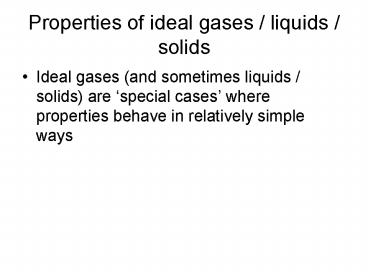Properties of ideal gases / liquids / solids - PowerPoint PPT Presentation
1 / 13
Title:
Properties of ideal gases / liquids / solids
Description:
Properties of ideal gases / liquids / solids Ideal gases (and sometimes liquids / solids) are special cases where properties behave in relatively simple ways – PowerPoint PPT presentation
Number of Views:288
Avg rating:3.0/5.0
Title: Properties of ideal gases / liquids / solids
1
Properties of ideal gases / liquids / solids
- Ideal gases (and sometimes liquids / solids) are
special cases where properties behave in
relatively simple ways
2
special cases
- As an example, consider the ideal gas law, PvRT.
This law is plotted in red. Note the behavior
is simple compared to the true behavior in blue. - Note also that the blue and the red curves
converge far above and to the right of the vapor
dome. In general, superheated vapors far from
the vapor dome will behave as ideal gases, and
will exhibit this simple behavior.
3
The problem with special cases
- Because PvRT is simple to compute, the book does
not list specific volume, v, in tables for ideal
gases. See for example table A-17. - Then, although it is simple, it is still harder
than if they just listed it in the table, because
you have to do a computation (however, on the
plus side, you do not have to interpolate)
4
EES and special cases
- Since EES allows property lookups for special
cases and non-special cases alike, this is all
behind the scenes. Therefore, these special
cases are sort of transparent in EES. However,
you will see special cases show up in EES, for
example, like this
- To remedy the above warning, you just drop the P
specification in the parentheses. In the same
way that PvRT is a simple relationship, h and u
are both simpler than the general case for ideal
gases they are functions of temperature only.
EES wants to remind you of that, thats why it
doesnt want other properties besides temperature
to be input
5
u u(T) for an ideal gas
- You can see that u is independent of pressure in
the ideal gas zone (far from the vapor dome) in
the plot. - Also note that there are actually 5 regions
labeled in this plot rather than the usual 3 of
compressed liquid, saturated mixture, and
superheated vapor - h h(T) as well for an ideal gas since h u
Pv and Pv RT. - You can see u u(T), h h (T) in table A-17.
6
How far from the vapor dome does a gas become an
ideal gas?
- It depends upon how good you want the ideal gas
approximation to be - This Figure is 3-49. The numbers are
- Biggest numbers here are near the critical point,
but even bigger numbers would show up for liquid
7
Straight lines on property plots are a sign of a
special case
- Each of the straight lines in the P-h diagram for
water represents some kind of special case.
There are 3 different straight lines here. What
does each mean?
8
Ideal gas formulas (1)
(approximate)
(approximate)
9
Three ways of calculating Du
10
Ideal gas formulas (2)
(approximate)
(approximate)
11
Property relations for isentropic processes
involving ideal gases
12
Other special cases
- This presentation has focused on ideal gases but
there are also formulas for special-case liquids
and solids, see e.g. section 4-5 pg 189 and
section 7-8 pg 357
13
What should I study relative to property
calculations on exams?
- I will generally give you tables (e.g., problems
involving steam) - If I gave you a problem that required you to use
formulas to calculate properties, I would lead
you through it. - If you can do steam problems on paper and air
problems in EES you should be fine.

